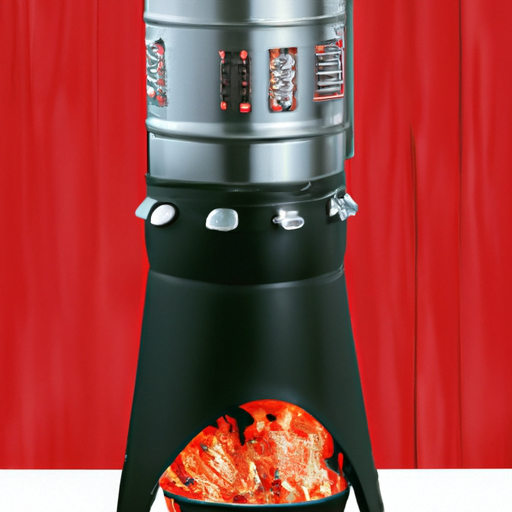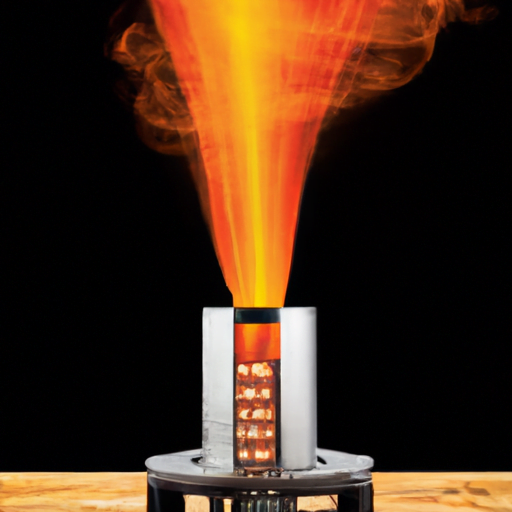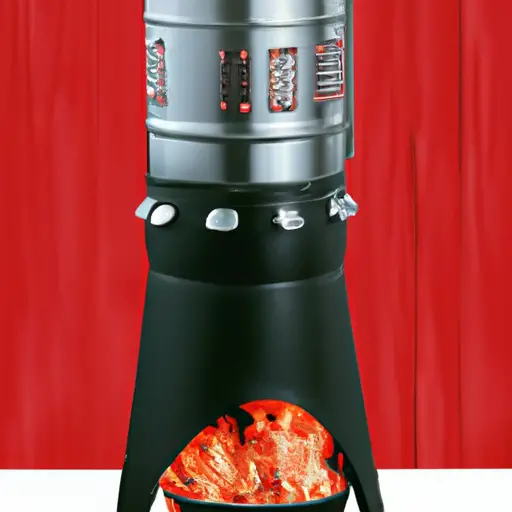Have you ever wondered how people manage to live off the grid? It seems like such a foreign concept, but it’s actually becoming more popular. One of the key components of off-grid living is having a reliable and efficient cooking system. That’s where a rocket stove comes in. But how does it work exactly? In this article, we’ll dive into the mechanics of a rocket stove and explore how it provides a sustainable and eco-friendly option for cooking off the grid.
So what exactly is a rocket stove? Well, it’s a simple yet ingenious design that uses a small amount of fuel to generate a lot of heat. The basic mechanics of a rocket stove involve an insulated combustion chamber, a vertical chimney, and an air intake. When you light the fire in the combustion chamber and open the air intake, the hot gases rise up the chimney, pulling fresh air in through the intake. This creates a strong draft that fuels the fire and allows for efficient and clean combustion.
The efficiency of a rocket stove is what sets it apart from traditional cooking methods. Because of its design, it is able to reach high temperatures quickly and maintain them with minimal fuel consumption. This means that less wood or biomass is needed to cook your meals, making it a great option for those who are conscious of their carbon footprint. Plus, its compact size and portability make it ideal for camping or emergency situations when you need a reliable cooking source. In the next article, we’ll discuss the different types of rocket stoves and how you can build one yourself. Stay tuned for more!

Understanding Off Grid Living
Benefits of Off Grid Living
Living off-grid has become increasingly popular in recent years as people seek more sustainable and self-sufficient lifestyles. The benefits of off-grid living are numerous and varied. One of the primary benefits is the independence it offers. By generating your own power, collecting rainwater, and growing your own food, you become less reliant on external sources for your basic needs.
Off-grid living also provides a unique opportunity to reduce your carbon footprint. By using renewable energy sources such as solar panels and wind turbines, you can significantly decrease your impact on the environment. Additionally, off-grid living promotes a more minimalist lifestyle, encouraging people to be mindful of their consumption and waste production.
Furthermore, off-grid living can provide a sense of freedom and connection with nature. Being away from the busy urban areas allows you to enjoy the peace and tranquility of the natural surroundings. It also offers the opportunity to disconnect from the constant distractions of technology and reconnect with yourself and your loved ones.
Challenges of Off Grid Living
While off-grid living has its undeniable advantages, it also comes with its fair share of challenges. One of the main challenges is the initial cost of setting up an off-grid system. The investment required for solar panels, batteries, and other equipment can be substantial. However, it is important to consider this as a long-term investment, as the savings on utility bills and the potential increase in property value can offset these costs over time.
Another challenge is the reliance on weather conditions. As your energy source primarily comes from solar or wind power, extended periods of cloudy or calm weather can affect the availability of power. This means you may need to have backup systems in place, such as a generator or alternative energy sources, to ensure a consistent power supply.
Water management is another crucial aspect to consider. Collecting and storing rainwater requires careful planning and maintenance. Additionally, off-grid living often requires individuals to be more mindful of their water usage, as water resources may be limited.
Importance of Efficient Cooking Systems
Efficient cooking systems are an essential component of off-grid living. Traditional cooking methods, such as open fires and conventional stoves, can be highly inefficient and polluting. This is where rocket stoves come into play, offering a cleaner and more sustainable alternative.
Introduction to Rocket Stoves
Definition and Purpose of Rocket Stoves
A rocket stove is a highly efficient cooking device that uses a small amount of wood or biomass fuel to produce a powerful flame. Its design is based on the principles of combustion and heat transfer, aiming to maximize fuel efficiency and minimize harmful emissions. The primary purpose of a rocket stove is to provide a sustainable and economical way of cooking off-grid.
Historical Background of Rocket Stoves
Although rocket stoves have gained popularity in recent years, their roots can be traced back to the 1980s when Dr. Larry Winiarski, an American engineer, developed the concept to address deforestation issues in developing countries. His creation revolutionized cooking methods by reducing fuel consumption and minimizing smoke emissions.
Advantages of Rocket Stoves
Rocket stoves offer several advantages over traditional cooking methods. Firstly, they are incredibly efficient, requiring much less fuel compared to open fires or conventional stoves. This results in significant cost savings and a reduced need for firewood, which can be particularly beneficial in areas where deforestation is a concern.
Furthermore, rocket stoves produce very little smoke and harmful emissions. The design of the stove allows for complete combustion of the fuel, minimizing air pollution and health risks associated with indoor smoke inhalation. This is especially important in developing countries, where indoor air pollution is a leading cause of respiratory illnesses.
Basic Mechanics of a Rocket Stove
Primary Components of a Rocket Stove
A rocket stove consists of three primary components: a combustion chamber, a fuel magazine, and a chimney. The combustion chamber is where the fuel is burned, and it is specifically designed to promote efficient combustion. The fuel magazine holds the wood or biomass fuel, allowing it to be gradually fed into the combustion chamber. The chimney facilitates the upward flow of hot gases and provides the necessary draft for efficient combustion.
Flow of Air and Fuel in a Rocket Stove
The flow of air and fuel in a rocket stove is critical for its efficient operation. As the fuel is burned in the combustion chamber, hot gases are produced and directed through a narrow, insulated chimney. This narrow chimney creates a strong draft, pulling air into the combustion chamber and supplying oxygen for the combustion process. The combination of the strong draft and efficient combustion results in a clean and intense flame.
Principles of Combustion in a Rocket Stove
Rocket stoves operate on the principle of a “rocket effect,” where the high heat and gases produced during combustion create a powerful upward draft. This draft ensures that the fuel is burned efficiently, with minimal smoke and waste. The design of the combustion chamber and chimney maximizes heat transfer and encourages complete combustion, resulting in a highly efficient cooking system.
Construction and Design of Rocket Stoves
Materials Used in Rocket Stoves
Rocket stoves can be constructed using various materials, depending on the availability and intended use. The core components, such as the combustion chamber, are typically made of heat-resistant materials like refractory bricks or metal. Insulating materials, such as vermiculite or perlite, are added to reduce heat loss and increase efficiency.
Key Design Features of Rocket Stoves
The design features of a rocket stove contribute to its efficiency and effectiveness. A key design element is the size and shape of the combustion chamber, which is carefully engineered to promote efficient combustion and heat transfer. The chimney diameter and height are also critical in creating the necessary draft for optimal airflow.
Modifications and Enhancements
Over the years, various modifications and enhancements have been made to the original rocket stove design. These modifications include the addition of heat exchangers to capture and utilize waste heat for other purposes, such as water heating or space heating. Other enhancements focus on improving the stove’s portability and ease of use, making it accessible to a wider range of users.

Efficiency and Environmental Impact of Rocket Stoves
Energy Efficiency in Rocket Stoves
Rocket stoves are revered for their high energy efficiency. Compared to traditional cooking methods, they require significantly less fuel to achieve the same cooking results. This not only saves money but also helps reduce deforestation and carbon emissions. The efficient combustion and heat transfer mechanisms within a rocket stove ensure that the fuel is utilized to its maximum potential, minimizing waste.
Reduction of Harmful Emissions
One of the most significant environmental benefits of rocket stoves is their reduction in harmful emissions. By promoting complete combustion, rocket stoves minimize the release of smoke, carbon monoxide, and other pollutants. This improves indoor air quality and reduces the impact on both human health and the environment.
Comparison with Traditional Cooking Methods
When compared to traditional cooking methods, rocket stoves offer substantial improvements in terms of efficiency and environmental impact. Traditional open fires and stoves are notorious for their low efficiency and high emissions. In contrast, rocket stoves provide a cleaner and more sustainable alternative, making them particularly suitable for off-grid living.
Applications and Uses of Rocket Stoves
Cooking and Heating Applications
The primary application of rocket stoves is for cooking. Whether it’s boiling water, simmering a stew, or frying food, a rocket stove can efficiently and effectively meet the cooking needs of off-grid living. However, rocket stoves can also be utilized for other purposes, such as space heating and water heating. The ability to incorporate heat exchangers and supplementary systems expands the possibilities for their use in various settings.
Space Heating and Water Heating
By incorporating heat exchangers into the design, rocket stoves can be used to heat the surrounding space or provide hot water for domestic use. This can be particularly useful in colder climates or during the winter months when additional heating is required. Rocket stoves offer a sustainable alternative to traditional heating methods, reducing reliance on fossil fuels and lowering environmental impact.
Community and Humanitarian Efforts
Rocket stoves have also found applications in community and humanitarian efforts. In areas where access to electricity and clean cooking fuels are limited, rocket stoves provide a safe and efficient way to cook food, as well as heat and light their surroundings. These stoves have been particularly beneficial in disaster relief operations, refugee camps, and rural communities, improving the quality of life for those in need.
Common Challenges and Troubleshooting
Obstacles Faced while Using Rocket Stoves
While rocket stoves are highly efficient and reliable, they can still present challenges. One common challenge is the availability of suitable fuel. Rocket stoves are designed to burn wood or biomass, so it is essential to have a sustainable and accessible fuel source. Additionally, operating a rocket stove requires some practice and knowledge to ensure proper airflow, temperature control, and efficient combustion.
Maintenance and Cleaning Tips
To ensure optimal performance and longevity, regular maintenance and cleaning of a rocket stove are necessary. Removing ash and debris from the combustion chamber and chimney should be done periodically to prevent blockages and maintain proper airflow. It is also important to inspect the stove for any signs of damage or wear and address them promptly.
Troubleshooting Common Issues
In the event of common issues, such as poor combustion or inadequate heat output, troubleshooting techniques can help identify and resolve the underlying problems. This may involve adjusting the air intake, checking for obstructions in the chimney, or ensuring proper fuel supply. Comprehensive user manuals and online resources can provide detailed guidance on troubleshooting specific rocket stove models.
Safety Considerations and Precautions
Fire Safety Measures
Safety should always be a primary concern when using a rocket stove. Proper placement of the stove, away from flammable materials and in a well-ventilated area, is essential to prevent the risk of fire. Additionally, it is crucial to have fire extinguishing equipment readily available, such as a fire extinguisher or a bucket of sand, in case of emergencies.
Carbon Monoxide and Smoke Concerns
While rocket stoves produce minimal smoke and emissions compared to traditional cooking methods, it is still important to be mindful of carbon monoxide and smoke concerns. Proper ventilation is necessary to ensure the safe removal of any residual gases. It is also advisable to install carbon monoxide detectors in the area where the rocket stove is used to provide early warning of potential hazardous situations.
Proper Ventilation and Airflow
Creating and maintaining proper ventilation and airflow is vital when using a rocket stove. Sufficient airflow is necessary for efficient combustion and to minimize the risk of smoke or fumes accumulating indoors. Ensuring that your living space has adequate ventilation through windows, vents, or exhaust fans helps maintain a safe and healthy environment.
Evaluating the Pros and Cons of Rocket Stoves
Advantages of Rocket Stoves
Rocket stoves offer numerous advantages that make them an appealing option for off-grid living. They are highly efficient, reducing fuel consumption and costs. They also provide a sustainable alternative to traditional cooking methods, minimizing environmental impact. Rocket stoves are versatile, with applications ranging from cooking to heating, and have been instrumental in community and humanitarian efforts.
Limitations and Drawbacks
Despite their many advantages, rocket stoves do have some limitations and drawbacks. One common limitation is the need for a consistent and accessible supply of fuel, which may not be readily available in all areas. Rocket stoves also require some level of skill and knowledge to operate effectively. Additionally, the initial cost of purchasing and installing a rocket stove may be higher compared to traditional cooking equipment.
Cost Considerations
When evaluating the cost of a rocket stove, it is essential to consider the long-term savings and benefits. While the initial investment may be higher, the reduced fuel consumption and potential savings on utility bills can offset these costs over time. Moreover, the environmental benefits and self-reliance that come with off-grid living can have intangible value that goes beyond monetary considerations.
Conclusion
In conclusion, rocket stoves offer an efficient and sustainable solution for off-grid cooking and heating needs. Understanding the mechanics behind a rocket stove, from its primary components and airflow to combustion principles, lays the foundation for harnessing its numerous benefits. While off-grid living may present challenges, rocket stoves provide a reliable and environmentally friendly cooking option that promotes self-sufficiency and minimizes environmental impact. Whether it’s in your backyard, during camping trips, or in humanitarian efforts, rocket stoves have the potential to revolutionize the way we cook and heat our living spaces. So why not explore the mechanics and possibilities of rocket stoves and embark on a journey towards a more sustainable and self-sufficient lifestyle?




